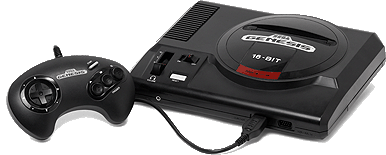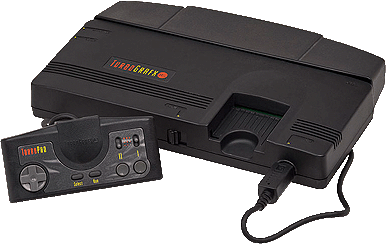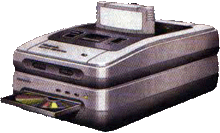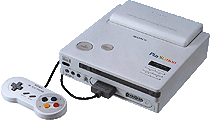

Sega achieved modest success in Japan and even better results in Europe with its 8-bit Master System that went up against the NES. It was ruling the arcade scene with fancy games like OutRun, Space Harrier, and Afterburner. To capitalize on the arcade scene, Sega set out to create a more advanced 16-bit system that could better replicate the advanced graphics seen in arcades and bring those games to life at home on the television. In 1988 the Sega Mega Drive was released in Japan. A year later it would be released in the U.S. as the Sega Genesis, one of the most popular systems ever that would go on to sell over 30 million units and have a library of over 850 games. This new powerhouse ran circles around the 8-bit NES in both graphics power and audio. Sega was the primary game maker for the system when it first arrived, packed in with the arcade hit Altered Beast. A string of arcade ports would follow, such as Golden Axe and Revenge of Shinobi.
Sega of America wasn't just sitting idly by as Nintendo took over the living rooms across the U.S. They were taking notes, and one thing became abundantly clear: Sega would need help if they hoped to battle Nintendo. This time they formed strategic partnerships with third parties, many of which were American-based companies that didn't like Nintendo's strict licensing requirements. One of them in particular would help cement Sega as a strong contender while at the same time bolstering their own company. That small software company was Electronic Arts, or EA as they're better known today. By bringing realistic (for the time) licensed sports games to the Genesis, EA launched a whole new brand of games centered on some of America's most precious pass-times. This was how the famous Madden NFL games came to power, and it lured in a whole new demographic. Instead of focusing on children ages 6 to 12, Sega spent considerable money on marketing to target older gamers. They also relished in taking jabs at Nintendo, featuring ads with the slogan: "Genesis does what Nintendon't". This strategy ended up working so well, that by the time Nintendo got around to introducing its own 16-bit system in August of 1991, Sega has a full 2 years to sell millions of systems.
By 1993 Sega had sold over 12 million consoles just in the U.S. and accounted for 45% of the market versus Nintendo's 44%. In Europe they commandeered a staggering 66% of the video game industry. Times had changed for Sega and more and more developers were jumping over to Sega's machine to get a piece of the action. While Nintendo kept a stranglehold on popular Japanese developers, like Square, Enix, Capcom, and Konami, western developers and publishers released some of the most original and captivating games of the era. In order to avoid souring deals with Nintendo, Capcom got in on the Genesis early by licensing games (like Ghouls & Ghosts) to Sega and having them publish them. By the time 1993 rolled around Capcom was straight up publishing multiple games a year for the competing platform as its user base could no longer be ignored.
When all was said and done, the Genesis sold extraordinarily well and managed to eat away at Nintendo's stranglehold on the market. It grew the gaming industry to include teens and adults and ushered in the era of game ratings by allowing violent content to appear in the games, where Nintendo had not done so in the past. Games like Mortal Kombat, Night Trap, and Eternal Champions were edgy and mature, but also bloody and filled with gore. Sega pushed the boundaries of what content was considered appropriate in a video game, laying the groundwork to the industry we have today.
For all of its success, Sega made some colossal mistakes. Scared of Nintendo regaining market share with its Super Nintendo, Sega released a slew of add-ons that would only serve to segment its audience, confuse customers, and lose focus on what was important: the games. Sega CD, an expensive accessory ($299 at launch) failed to sell. The 32X, a device that attached to the top of the Genesis to allow for 32-bit cartridges with better graphics, was dead on arrival. The Sega Game Gear handheld sold horribly when compared to Nintendo's Game Boy. By the time 1995 rolled around, Nintendo had regained the lead in all territories, except Europe, and was making huge strides there as well. It was once again time for a console transition and Sega was about to release its biggest mistake ever (Sega Saturn), one that would lead to the disintegration of the company as a hardware maker and allow for a new competitor (Sony) to take over the gaming industry.


In Japan, as well as in the U.S., Nintendo was king of the hill in the 1980s. By the time 1987 rolled around, Sega had barely made a dent in Nintendo's stranglehold over the Japanese video game market. NEC, a computer company known for making PC parts partnered up with Hudson, one of the larger third party supporters of Nintendo to create a brand new console called the PC-Engine. This small machine packed a lot of punch with its cutting edge 16-bit graphics and faster processor, the system was able to display graphics that had never before been seen on home consoles. Pixel-perfect ports of R-Type and Galaga 88 drove Japanese consumers to buy the machine en masse. This same system was released in 1989 in the U.S. as the TurboGrafx-16, alongside the more powerful Sega Genesis. With Sega's genius marketing on one side and Nintendo's muscling of the market on the other, it's no surprise that the system would only find a small audience over here.
Several innovations kept the PC-Engine selling well in Japan. In 1988 a CD-ROM attachment was released, allowing games to have more storage, which meant room for more frames of animation, full CD audio, and anime cinema scenes ripped right out of popular television and film. The system would become so popular that it ended up selling over 7 million units and had over 650 games released for it. It was supported all the way up until 1996, but never saw a release in Europe and sales stagnated in the States. It did have a wide variety of games, and those gamers that enjoyed excellent arcade ports and original Japanese role playing games were extremely pleased to own the system. With a 5-player adapter and the best versions of Bomberman available, the TurboGrafx-16 became one of the first party systems where a bunch of friends could gather around the TV and battle it out. Years later, in 2007, many of the classic games released for the system appeared again on the Wii via its Virtual Console, giving a whole new generation of gamers a chance to play some of the best games of the late 80s and early 90s.


Nintendo was in no hurry to release its successor to the Nintendo Entertainment System. In fact, if it wasn't for Sega's strong push of the Genesis, we may have waited several more years for Nintendo's 16-bit machine. Even though Sega was slowly chomping away at Nintendo's market, it was still selling hundreds of thousands of systems every month and a ton of games and accessories on top of that. The 8-bit Nintendo was still very much king and Nintendo knew that releasing its successor too soon would simply eat into its own profits. Finally, at the end of 1990 in Japan, and in August of 1991 in the U.S., Nintendo put out the Super Nintendo Entertainment System (SNES) (Super Famicom in Japan) for $199.99. It came with 2 controllers and Super Mario World, the successor to the wildly popular Super Mario Bros. 3 that had come out 2 years prior. The pad increased the number of buttons from 2 to 4 on the face and added revolutionary shoulder buttons on the top of the pad. These would be used in a variety of ways over the years, but racing games, like F-Zero, used them in conjunction with the d-pad to make sharper turns around tight corners.
The Super Nintendo had a slower cpu than the Genesis, but it had a custom graphic processor and sound chip that elevated it above what Sega's machine was capable of. Instead of the grinding and somewhat mechanical music heard on the Genesis, the Super Nintendo could produce an entire orchestra. Early games like Actraiser and Super Castlevania IV really showed off the sound chip, but it was Final Fantasy II released near the end of 1991 that really showcased the amazing music that could be produced from a tiny machine. The SNES also had a few graphical tricks up its sleeve. It had built-in Mode 7 graphics, which meant it could realistically rotate and scale backgrounds to make the games look 3D. Right at launch, Nintendo showed off two games that made use of this new technology: F-Zero and Pilotwings. Both were original games and wouldn't be possible to replicate on competing machines.
As it had done with the NES, Nintendo curated the best of the best third parties to create games for its system. Not only did it have practically every developer in Japan on board, but it had also made inroads in America to get Electronic Arts on board with its wide library of sports games. Even a small, somewhat unknown company at the time named Blizzard made games for the SNES. They would later go on to become one of the most profitable software companies of all time when they released games like World of Warcraft, Diablo, and StarCraft. Combining the amazing third party games from Japan, like Final Fight, Super Ghouls & Ghosts, Street Fighter 2, and Mega Man X with heavy-hitters from America like Mortal Kombat 2 and Madden, Nintendo had games for everyone of all ages and covered every genre imaginable. It's no wonder then that the Super Nintendo would go on to sell over 50 million systems worldwide with over 2000 games created for it.
Facing more competition from Sega with its Sega CD, Nintendo countered that move by joining up with Sony. In 1992 it was announced that Nintendo would be releasing a CD-ROM add-on to the SNES and it would be called the PlayStation. This new machine would hook onto the bottom of the existing SNES and increase its memory and allow for bigger, more detailed games to be created. However, in a radical turn of events, Nintendo backed out of the deal at the last minute, just before the unit was to be shown off publicly at a trade event. They realized that handing over the royalties of games being created for the device to Sony that they would be missing out on a ton of income they would normally get from producing the cartridges. Fearing this, they cancelled the deal and signed on with a competitor called Phillips. This enraged Sony to the point where they decided not to scrap the project, but to create it themselves with a more powerful graphics chip and a 32-bit processor. They would later release it themselves as the Sony PlayStation, which would become so wildly successful that it changed the video game landscape forever.
The Phillips deal never took off and Nintendo never did release a CD-ROM add-on for the SNES. Instead, Nintendo focused on new chips that could be stuffed inside its existing cartridges. The first of which was the Super FX chip. This allowed games to be powered by polygons. The first game to use this new technology was Star Fox in 1993. It was a huge hit and just the beginning of what Nintendo planned to do with this new polygon tech. Around this time Jurassic Park was all the rage at the theatres. Nintendo liked the technology that was used to bring the dinosaurs to life on the big screen. Using similar SGI computer workstations, they partnered with Rare to bring out Donkey Kong Country with pre-rendered graphics. The game was an amazing success worldwide and featured graphics never before seen on a console. It was obvious that the SNES was capable of reinventing itself by releasing fresh new games on a consistent basis with new technology. During this time games like Super Metroid, Super Mario RPG, Super Punch-Out, Super Mario Kart, Earthbound, and Yoshi's Island all saw massive success, making the Super Nintendo the eventual winner of the 16-bit console wars.
 2.
2. 
 4.
4. 
 6.
6. 
 8.
8. 
 10.
10. 




 2.
2. 
 4.
4. 
 6.
6. 
 8.
8. 
 10.
10. 
 2.
2. 
 4.
4. 
 6.
6. 
 8.
8. 
 10.
10. 

